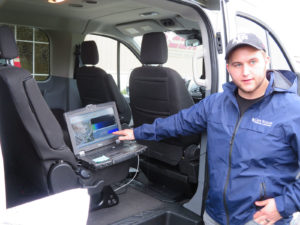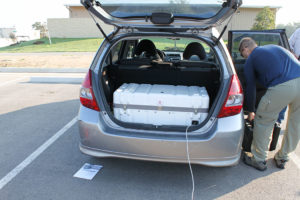How do we ensure that big events like the Superbowl, the Olympics, or even the weekly Aggie tailgate do not become the site of a nuclear terrorist attack? Student researchers under Dr. Craig Marianno in the Center for Nuclear Security Science and Policy Initiatives (NSSPI) have been working to identify and respond to many of the challenges involved in detecting radiological materials an adversary may try to smuggle into sites filled with thousands of people spread over a large area.

One of those student researchers is Ph.D. student Jackson Wagner. According to Wagner, “Terrorism has been a perennial threat to the United States, and with that there is always a small possibility of a nuclear terrorism incident. If this were to happen, an adversary would likely use a radiological dispersal device (commonly known as a ‘dirty bomb’) or an actual nuclear device in an attack, especially one on a public event that would attract a large group of people.”
Large public events pose a unique challenge for nuclear security operations. In such scenarios, security personnel generally use radiation detection systems to distinguish the presence of illicit radiological materials, and one common employment method for detection systems in this context is the mobile search system. A mobile search system could consist of detectors placed in a vehicle, which then traverses an area to verify that no illicit radiological materials are present. A pedestrian with a backpack-based mobile detection system could also perform a more detailed search of a smaller area or search an area that a vehicle cannot access.
In order for mobile search systems to work well, the radiation background must be properly characterized to help reduce the number of false alarms. Wagner’s research focuses on developing a method to predict the ambient neutron count rate in detection systems commonly used in nuclear security scenarios. Using these detectors to determine the presence of an illicit source requires the knowledge of the detectors’ ambient responses, which is relatively simple for gamma rays, but it is more difficult for neutrons. A method to estimate the ambient neutron response applies an observed correlation between the neutron detector response and the gamma detector’s high energy response in many scenarios. The improved knowledge of the ambient neutron detector response that this method would provide will make it easier for these systems to locate neutron sources (which is generally indicative of special nuclear materials).

“My work will devise a method to improve these systems’ neutron detection capabilities, which will use a rarely applied data stream to estimate the expected neutron background while these systems are operating,” explains Wagner. “In knowing the expected background, these systems will be less likely to trigger a false alarm and thus reduce the time wasted adjudicating those false alarms. This method also has the potential to improve the sensitivity of these neutron detection systems, allowing mobile search operators to find smaller amounts of neutron-emitting materials.”
Jackson received a Bachelor of Science in Engineering degree in Nuclear Engineering and Radiological Sciences from the University of Michigan – Ann Arbor in 2016. He will be defending his dissertation work on radiation background characterization and graduating with a Ph.D. in Nuclear Engineering from Texas A&M University in 2021.